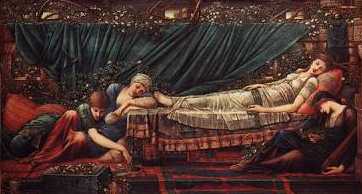The fateful slumber floats and flows...
About the tangle of the rose.

But lo the fated hand and heart...
To rend the slumberous curse apart
...|
The fateful slumber floats and flows... About the tangle of the rose. |
|
But lo the fated hand and heart... To rend the slumberous curse apart ... |
The origins of this story included Giambattista's 'Sun, Moon and Talia'. Here, Giambattista drew a story of adultery and savagery. Instead of a prince, he introduces a king who encounters the sleeping princess, Talia. No matter what the king does, Talia does not awaken so the king rapes her and afterwards goes back to his spouse. While still asleep, Talia gives birth to twins, Sun and Moon. She awakens when the splinter, by chance, gets sucked out of her finger. The barren queen learns about this and tricks the children to court. She then orders the cook to kill and serve them. Talia is then sentenced to be burned at the stake for sleeping with the king. When the king arrives just in time, the queen taunts him that he had been eating his own children. The king, in his rage, throws the queen into the fire. The cook then admits that he killed a kid instead of the children. The king then marries Talia and they all live happily ever after.
Perrault drew his story, entitled Sleeping Beauty of the Wood, from here, but his did not dwell in adultery, instead, he focused on cannibalism. The princess awakens just as the prince kneels before her. They fell in love and marry right away. The prince is hesitant to bring his wife to his home since his mother is from the line of ogres. When his father dies and he is made the new king, he introduces his wife, as well as their two children, to his subjects. Once while away on a war, he forgets about his mother being an ogress. Try as she might to overcome her hunger, the ogress cannot fight it. She orders the young princess, Morning, the young prince, Day, and the queen cooked. Like Giambattista's story, the cook kills an animal to replace them and when the ogress learns of his deception, she orders them to be thrown in a pit full of vipers and toads. The king arrives in time and the queen, in her anger, throws herself into the pit.
The Grimms' version entitled Brier Rose, and which storyline is more popular, ends with the awakening of the princess which is caused by the prince's kiss and the end of the one hundred years of enchantment.
Disney's version, however, no longer concerns a hundred years of enchantment. Instead, 'Aurora' is rescued by her prince as soon as he breaks free from Maleficent's (the evil witch) captivity. Also, another element, the betrothal of Prince Philip and Princess Aurora is introduced, including more animated characters which originally have just fleeting roles. Prior meeting of the prince and princess before the enchantment as well as the fight between Prince Philip and Maleficent add spice to the general atmosphere of the animation.
Sources:
Grimm, Jakob and Wilhelm Grimm, The Complete Fairy Tales of the Brothers Grimm, ed. Jack Zipes
The Uses of Enchantment
, Random House, New York, NY: 1977.Perrault, Charles, "Sleeping Beauty of the Wood", The Blue Fairy Book, ed. Andrew Lang
back to main